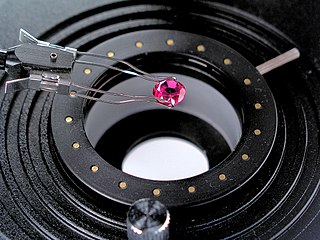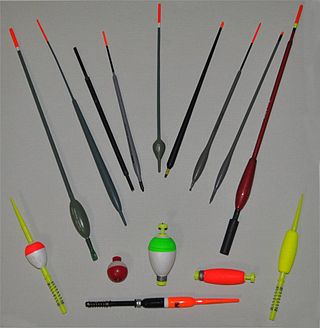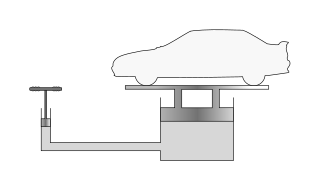
An Urinometer is a simple piece of equipment for determining urine specific gravity. [1]

An Urinometer is a simple piece of equipment for determining urine specific gravity. [1]
A typical urinometer is composed of a float, a weight, and a stem. The float is an air-filled glass tube, ending in the weight on the left and the stem on the right. The weight is a bulb filled with ball bearings embedded in a red solid, probably a glue of some sort. The glass stem extends to the right, and has calibrated graduations and numbers marked off to indicate specific gravity measurements. [2]
An urinometer is typically used in medical diagnostic labs. It is placed in a tube of urine, and where the meniscus of the urine reaches displays the specific gravity of the urine.

Relative density, also called specific gravity, is a dimensionless quantity defined as the ratio of the density of a substance to the density of a given reference material. Specific gravity for liquids is nearly always measured with respect to water at its densest ; for gases, the reference is air at room temperature. The term "relative density" is preferred in SI, whereas the term "specific gravity" is gradually being abandoned.

A barometer is a scientific instrument that is used to measure air pressure in a certain environment. Pressure tendency can forecast short term changes in the weather. Many measurements of air pressure are used within surface weather analysis to help find surface troughs, pressure systems and frontal boundaries.

Gemology or gemmology is the science dealing with natural and artificial gemstone materials. It is a geoscience and a branch of mineralogy. Some jewelers are academically trained gemologists and are qualified to identify and evaluate gems.
A hydrometer or lactometer is an instrument used for measuring density or relative density of liquids based on the concept of buoyancy. They are typically calibrated and graduated with one or more scales such as specific gravity.

Buoyancy, or upthrust, is an upward force exerted by a fluid that opposes the weight of a partially or fully immersed object. In a column of fluid, pressure increases with depth as a result of the weight of the overlying fluid. Thus the pressure at the bottom of a column of fluid is greater than at the top of the column. Similarly, the pressure at the bottom of an object submerged in a fluid is greater than at the top of the object. The pressure difference results in a net upward force on the object. The magnitude of the force is proportional to the pressure difference, and is equivalent to the weight of the fluid that would otherwise occupy the submerged volume of the object, i.e. the displaced fluid.
Archimedes' principle states that the upward buoyant force that is exerted on a body immersed in a fluid, whether fully or partially, is equal to the weight of the fluid that the body displaces. Archimedes' principle is a law of physics fundamental to fluid mechanics. It was formulated by Archimedes of Syracuse.

A Cartesian diver or Cartesian devil is a classic science experiment which demonstrates the principle of buoyancy and the ideal gas law. The first written description of this device is provided by Raffaello Magiotti, in his book Renitenza certissima dell'acqua alla compressione published in 1648. It is named after René Descartes as the toy is said to have been invented by him.

A rotameter is a device that measures the volumetric flow rate of fluid in a closed tube.
The specific weight, also known as the unit weight, is a volume-specific quantity defined as the weight per unit volume of a material.
A ballcock is a mechanism or machine for filling water tanks, such as those found in flush toilets, while avoiding overflow and backflow. The modern ballcock was invented by José Antonio de Alzate y Ramírez, a Mexican priest and scientist, who described the device in 1790 in the Gaceta de Literatura Méxicana. The ballcock device was patented in 1797 for use in steam engines by Edmund Cartwright.
The American Petroleum Institute gravity, or API gravity, is a measure of how heavy or light a petroleum liquid is compared to water: if its API gravity is greater than 10, it is lighter and floats on water; if less than 10, it is heavier and sinks.
The elevator paradox relates to a hydrometer placed on an "elevator" or vertical conveyor that, by moving to different elevations, changes the atmospheric pressure. In this classic demonstration, the floating hydrometer remains at an equilibrium position. Essentially, a hydrometer measures specific gravity of liquids independent of barometric pressure. This is because the change in air pressure is applied to the entire hydrometer flask. The submerged portion of the flask receives a transmitted force through the liquid, thus no portion of the apparatus receives a net force resulting from a change in air pressure.
Level sensors detect the level of liquids and other fluids and fluidized solids, including slurries, granular materials, and powders that exhibit an upper free surface. Substances that flow become essentially horizontal in their containers because of gravity whereas most bulk solids pile at an angle of repose to a peak. The substance to be measured can be inside a container or can be in its natural form. The level measurement can be either continuous or point values. Continuous level sensors measure level within a specified range and determine the exact amount of substance in a certain place, while point-level sensors only indicate whether the substance is above or below the sensing point. Generally the latter detect levels that are excessively high or low.

A refractometer is a laboratory or field device for the measurement of an index of refraction (refractometry). The index of refraction is calculated from the observed refraction angle using Snell's law. For mixtures, the index of refraction then allows the concentration to be determined using mixing rules such as the Gladstone–Dale relation and Lorentz–Lorenz equation.

Cannabis smoking is the inhalation of smoke or vapor released by heating the flowers, leaves, or extracts of cannabis and releasing the main psychoactive chemical, Δ9-tetrahydrocannabinol (THC), which is absorbed into the bloodstream via the lungs. Archaeological evidence indicates cannabis with high levels of THC was being smoked at least 2,500 years ago. As of 2021, cannabis is the most commonly consumed federally illegal drug in the United States, with 36.4 million people consuming it monthly.

A fishing float or bobber is a lightweight buoy used in angling, usually attached to a fishing line. Angling using a float is sometimes called float fishing.

Specific gravity, in the context of clinical pathology, is a urinalysis parameter commonly used in the evaluation of kidney function and can aid in the diagnosis of various renal diseases.
A mooring in oceanography is a collection of devices connected to a wire and anchored on the sea floor. It is the Eulerian way of measuring ocean currents, since a mooring is stationary at a fixed location. In contrast to that, the Lagrangian way measures the motion of an oceanographic drifter, the Lagrangian drifter.

Pascal's law is a principle in fluid mechanics given by Blaise Pascal that states that a pressure change at any point in a confined incompressible fluid is transmitted throughout the fluid such that the same change occurs everywhere. The law was established by French mathematician Blaise Pascal in 1653 and published in 1663.

A mercury relay is a relay that uses mercury as the switching element.